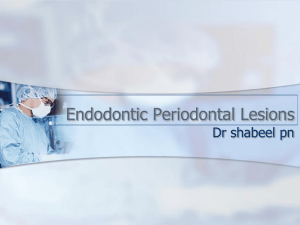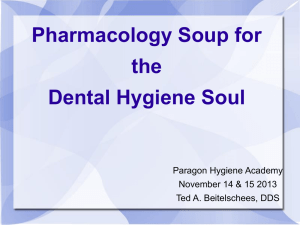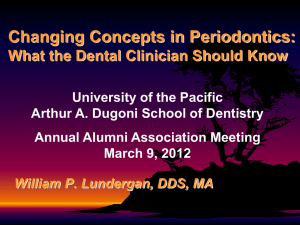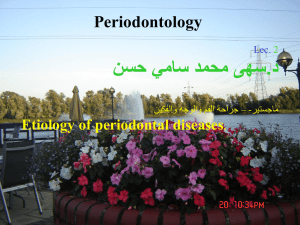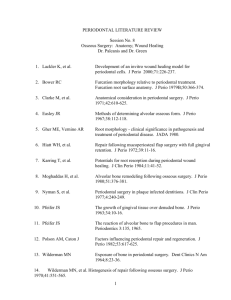Public Health in Periodontics
advertisement
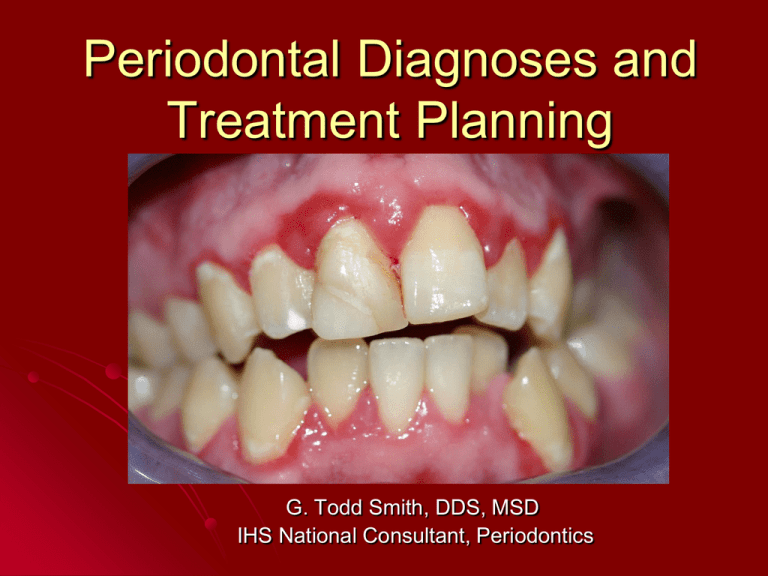
Periodontal Diagnoses and Treatment Planning G. Todd Smith, DDS, MSD IHS National Consultant, Periodontics Objectives: •Accurately detect periodontal diseases using a screening index. •Accurately diagnose and record a patient’s periodontal condition. •Analyze risk to determine treatment and recall intervals. Detection of disease CPITNCommunity Periodontal Index (of Treatment Needs), was developed in the mid 1980’s for screening populations. It is essentially the same as the PSR- Periodontal Screening and Recording, which was approved by the ADA and AAP in 1992 for screening patients for periodontal diseases. CPI/PSR Review 0 1 2 3 4 X Healthy Tissues Bleeding upon probing Calculus/overhangs and no depth >3mm At least one pocket 4-5mm deep At least one pocket 6mm or greater Less than 2 teeth/sextant Probe comparison: WHO vs 3-6-9-12mm This is the worst finding- a 3.5mm probing depth with no calculus or bleeding on probing What is the sextant score? Pre and Post Scaling & Root Planing 4 & 5mm pockets Healthy, with two 4mm pockets. No calculus or bleeding. Both sextants have CPITN scores of 3 PSR= 1 0 0 120 Same CPITN. Same diagnosis? Indicators of periodontal disease •Visual redness or swelling of papilla/gingiva •Bleeding on probing •Calculus •Pockets •Mobility •Furcation involvement •Recession •Loss of attachment •Radiographic bone loss CPITN/PSR doesn’t measure: Extent of disease in the sextant Magnitude of improvement Perio exams in a public health setting When? •AAP/ADA: Multiple sextant scores of 3 or > 1 sextant of 4 •Clinic’s policy, dependant on resources available. Note: If billing private insurance for SRPs, a perio exam should be provided Radiographs and bone loss Intraoral xrays underestimate defect depth by 1.4mm Zybutz 2000 Vertical defect depth underestimated by mean of 2.2mm Cadaver study, Langen 1995 Underestimation of bone loss: Okeson 1992 Panoramic 13-32% BW’s 11-23% PA’s 9-20% 30-50% of bone volume/density needs to be lost before detection on xray possible. Periodontal Diagnoses •Gingivitis- red, bleeding gums, sometimes enlarged, swollen, or tender. Generally with no attachment or bone loss. ------------------------ •Chronic periodontitis -usually slowly progressive disease with loss of gum attachment and bone. •Aggressive Periodontitis- Highly destructive, with rapid attachment loss and bone destruction, usually affecting patients under age 30 years of age. Location: Localized < 30% of sites involved Generalized > 30% of sites involved Severity: Slight- 3-4mm pockets, up to 30% bone loss Moderate 4-6 mm probings, up to 50% bone loss Severe > 6mm probings, >50% bone loss Other Periodontal Diagnoses •Abscesses of the periodontium •Perio-endo lesions •Necrotizing ulcerative gingivitis and periodontitis •Perio as a manifestation of systemic disease •Rare genetic and blood disorders (cyclic neuropenia, histiocytosis, leukemia) •Developmental or acquired deformities •Mucogingival deformities or conditions around teeth: For example recession, limited or no gingiva, high frenums, gingival overgrowth •Occlusal trauma- primary and secondary •Gingivitis on reduced periodontium •Use if the periodontitis has been treated and is stabile/not breaking down- no pockets increases or attachment loss Most diagnoses will be gingivitis or chronic perio! Examples of Classifying by Location, Severity, and Type of Disease Location Severity Type of Disease Gingivitis Generalized Moderate Chronic Periodontitis Generalized Severe Aggressive Periodontitis Localized Severe Necrotizing Periodontitis Gingivitis on a reduced periodontium Pathway to Periodontal Disease Genetic Risk Factors Antibody PMN Host Antigens Microbial ImmunoChallenge inflamLPS matory Other Response Virulence Factors Cytokines Connective Tissue Prostanoids and Bone Metabolism MMPs Environmental & Acquired Risk Factors Tissue Breakdown Products & Ecological Factors After Kornman, 1997. Clinical Signs of Disease Risk: predicts likelihood of developing disease and its future progression 33 y.o. with localized mild to moderate chronic perio in a well controlled diabetic who smokes 3-10 cigs/day. Taking diabetes, cholesterol lowering, and antihypertensive medications. 62 y.o. with generalized moderate chronic perio taking antihypertensive medications. Risk Diagnosis, prognosis, and treatment planning in the absence of risk information may result in over- or under treatment. Try putting patients into periodontal risk categories and match the intensity of treatment to risk: Low- no major risk factors Moderate- 1 risk factor High- 2 or more risk factors Page 2004 McGuire 2011 Kornman 2011 Major Risk Factors for Future Disease 1) 2) 3) 4) 5) Past history of periodontitis Smoking Type 1 and 2 diabetes mellitus Poor oral hygiene and irregular professional maintenance Obesity Major Risk Factors for Future Disease 6) Systemic factors and inflammation Rheumatoid arthritis Chronic kidney disease Hematologic disorders- e.g. leukemia Neutrophil deficiencies Agranulocytosis Neutropenia Leukocyte Adhesion Deficiency Histiocytosis Genetic diseases Cheidak Higashi Disease Down’s syndrome Papillon-LeFavre Other Periodontal Risk Factors: (which can become major risk factors) Stress & Immunocompromised individuals Hormonal variationsMultiple risk factors Certain medications increase risk exponentially; not just in Anatomic considerations an additive manner. IL-1 genetic polymorphism Nutritional factors 3 factors= 9X risk Nagelberg 2010 Faulty dentistry Alcohol Stabholz 2010 Kornman 2011 Public Health in Periodontics Identify those at low risk for periodontal breakdown Target those at high risk for perio breakdown Treat them before advanced perio occurs Provide individualized recall when appropriate Preventing Tooth Loss Recalls decrease tooth loss in patients with severe periodontitis. Recalls are more important for tooth preservation than plaque scores. Patients who didn’t comply with recalls were more than 5X more likely to have tooth loss. Checci 2002 Recall intervals can be extended beyond 6 months for low risk patients. Mettes 2005 Perio Treatment Planning and Patient Management Considering Risk Factors 1. Risk factor reduction Diet Oral hygiene motivation Smoking cessation Blood sugar control 2. Risk profile assessment Medical history Medications Perio Treatment Planning and Patient Management Considering Risk Factors 3. Eliminate infection Mechanical- ultrasonics and curets Surgical- blades or lasers Topical antimicrobials- toothpastes, mouthrinses Local antimicrobials - gels, chips, spheres Systemic antimicrobials – antibiotics, probiotics 4. Modulate the host response/inflammation Local with surgery- proteins, GFs, BMP Systemic- enzyme suppressors (LDD), antiinflammatories and antioxidants, NSAIDS (experimental) Perio Treatment Planning and Patient Management Considering Risk Factors Match the intensity of periodontal treatment to risk. Those at high risk: • • • • Aggressive monitoring Aggressive bacterial control- topical, local and systemic antibiotics Address modifying factors (OH, smoking, DM, xerostomia) Consider host modifying drugs (e.g. LDD, antioxidants, or anti-inflammatories) 38 y.o. with generalized moderate chronic periodontitis, taking dm and antihypertensive medications. No dental care X 8 yrs. HbA1c 9.2. PSR 3\2\3\4\3\4 1. 2. 3. 4. 5. 6. DM control? Physician consult? OHI mod Bass, interproximal care, mouthrinse Periodontal exam Scaling and root planing under LA Systemic antibiotic-doxycycline or amox & met Reevaluation with new perio exam in 3-6 mo a) b) c) d) e) Good result: Recalls every 3-6 months initially Poor result: Localized? Local antibiotic Generalized? Low dose doxycycline? Plaque sampling/salivary diagnostics? Motivate to OH! Check A1c. Periodontist referral if possible. 53 y.o. with localized moderate chronic periodontitis taking antihypertensive (lisinopril) and oral dm medications. HbA1c 7.2 1 0 2 3 2 3 1. 2. 3. 4. 5. OHI interproximal care No periodontal exam Dental prophylaxis, possible localized SRP No systemic or local antibiotic Perio recall 6 months. Check A1c and PSR 33 y.o. with localized mild to moderate chronic perio in a well controlled diabetic (HbA1c 6.8) who smokes 3-10 cigs/day. Hx cleaning elsewhere 1 yr ago. Taking diabetes, cholesterol lowering, and antihypertensive medications (amlodipine). No caries. 2 3 2 2 2 3 1. 2. 3. 4. 5. 6. Smoking cessation Physician consult OHI good; reinforce Periodontal exam Dental prophylaxis, possible localized SRP Perio recall 6 months. Check A1c and PSR 30 y.o. with gingivitis on a reduced periodontium, (generalized severe aggressive periodontitis; treated, on recall), good health, no meds, no caries, on recall 100 120 1. 2. 3. 4. 5. Periodontal exam if >1 year since last Reinforce OHI interproximal care Dental recall cleaning No systemic or local antibiotic Perio recall 6 months 32 y.o. with generalized moderate to severe chronic perio. Type 2 DM but doesn’t monitor BS. Taking oral hypoglycemics and lisinopril. No hx dental tx as an adult 4 3 4 4 4 4 1. 2. Motivational interview ? Rx HbA1c/physician consult OHI Perio exam SRP/LA with extraction of hopeless teeth (or full edentulation) Systemic doxycycline Reevaluation after 3-4 months Periodontist referral Removable prosthetics and 3 month recalls with good oral hygiene and periodontal health Current Trends in Nonsurgical Periodontal Treatment n=35RDH and DDS/DMD in CA, Jolkovsky,Inside Dent 11/2012 Periodontal exam and SRP: 1. … with antimicrobial irrigation- 71% 2. … with local antibiotics- 71% 3. … antimicrobial oral rinse- 77% 4. … with laser subg curettage- 20%, 5. … with systemic abx- 9%) No one did saliva testing or culture and sensitivity Note: Periodontist referral if > 5mm probings remain after treatment- 11% Povidone-Iodine-10% solution Betadine® and Aplicare® PI Prep solution Use 2.5 % (1/4 dilution) to 10% Solution Use in severe perio, HIV asso. perio, abscesses, or refractory disease Inexpensive Nasty Taste Use in a small syringe (3ml endo syringe) with a blunt needle- Dilute 1:1 and flush in the deeper pockets 3x over 10 mins immediately after scaling. J. Slots 2011 Contraindications: Allergy to iodine or shellfish Thyroid dysfunction Pregnancy Not for routine home care (decreases thyroid synthesis; goiter) Teamwork in managing perio in federally mandated programs Who is going to scale this patient? Establishing and Maintaining Perio Health in Federally Mandated Programs: Triaging Periodontal/Hygiene Care Hygienist/s able to meet the need. Regular recalls provided: DDS- Exam and Treatment Plan, Perio Tx? RDH- OHI, Perio Tx, and Recall DA- TB Prophy, OHI Establishing and Maintaining Perio Health Triaging Periodontal/Hygiene Care Hygienist/s unable to meet the need. Targeted recalls provided to those at moderate to high risk of breakdown: DDS- Exam and tx plan; perio tx of severe cases requiring extractions if desired. RDH- OHI, perio tx of moderate to severe cases, and those recalls. DA- Gingivitis to mild perio (CPITN 1,2,3), select gross debridements, prophys, and recalls. Establishing and Maintaining Perio Health Triaging Periodontal/Hygiene Care No hygienist Targeted recalls provided to those at moderate to high risk of breakdown: DDS- Exam and tx plan, perio tx of moderate to severe cases and their recalls. DA- Gingivitis to mild perio (CPITN 1,2,3), select gross debridements, prophys, and select recalls. Perio EF Clinics 3-4 Chairs Patients with CPITN’s of 1,2,&3 RDH or DDS provide check in and check out, and probings and anesthesia if indicated. DA provides OHI and ultrasonic therapy; hand scale with advanced training. Initial Therapy- Diabetic Protocol-1997 (SRP/LA and doxycycline 100mg bid X 14 d) 3 Months Re-evaluation 2010: After 13 years of very infrequent care. Re-tx SRP 2002 and 2008, 1 recall 2009. BS still in the 200’s. Gums healthier except upper ant. Generalized Severe Chronic Periodontitis 28 y.o. with FBS 347. Protocol treatment Perio health improved 2 months post-protocol Severe periodontal breakdown in a poorly controlled diabetic after no dental care for 2 years post protocol. Summary: •Save clinic time with the PSR screen. Know its limitations. •Treatment plan with risk evaluation- those at greater risk may need more aggressive therapy. •If all patients can be recalled-GREAT. If demand exceeds resources, target your recalls. •The consequences of periodontal undertreatment could be more than the loss of a few teeth. Questions? Gregory.Smith2@ihs.gov Questions? Gregory.Smith2@ihs.gov



